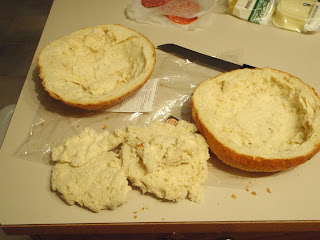The making of this activity book started with a string of texts...
Lisa: Do you want to make another activity book? My friend T is looking for one for her son S that would be a little older and have things like doing up zippers and tying shoes.
Jess: Ya, no! I don't think I want to make another one. But tell her there are tonnes of ideas on Pinterest and I did blog about R's. (Side note: First activity book link here)
Lisa: She saw the blog which is why she asked.
Jess: Kids do love them, R plays with hers all the time! But it's so annoying to make, it takes forever, and can get expensive if you have to buy all the fabric and bits and bobs.
Jess: How about I will see what I have downstairs already and maybe do a few pages for her and then she can flush out the rest?
Jess: I realize that I just went from no to yes...
Please notice that I didn't participate in the last part of that conversation. I'll let Jess take the story from here :)
~Lisa
OK, so sometimes I can be a bit soft... or maybe I was just hankering for a project to do. The first quiet activity book I made was for a 2 year old and this one is for a 4 year old.
Like I said in the texts, I just kind of scrounged up some stuff from my craft supplies. I did buy a few sheets of bright coloured felt but the rest of this stuff I had on hand. Make do with what you have!
The first page here is a "racetrack". There are little "cars" inside each one, and he can "drive" the "cars" around the road maze "racetrack".
I sewed the fabric on the page using a straight stich and created paths into it, making a little maze. Then I put two beads in each maze and zig-zagged the edges down.
Using felt I cut out the black shoe bottoms and the orange shoe tops. Then cut little holes in the orange shoe tops for the laces. I sewed this down with a straight stich and then threaded the string laces in the shoes. Practice tying shoes, fisherman knots, or whatever.
The flower pot page is started with green stems, sewn down with a narrow zig-zag. Then the pot is sewn on 3 sides, making a little pocket for all the flowers. The flowers are cut from colourful fabric scraps that I ironed interfacing to, this adds structure to the blooms and makes sure the edges don't fray. I made about 12 flowers and tucked them into the flower pot pocket. I sewed a button or two on each stem to attach the flowers.
The letters are cut out of blue felt. I put a small piece of Velcro on the back of each letter and on each space. Spell your name or practice other words. I cut out spare letters too, and put them all in the little zipper pouch. I even including the letters for his sisters' name, I cut those out in red.
This page is about counting and basic math. Just string some beads on yarn and then sew the ends of the yarn down to the page. Count 1 to 10 on the beads or add and subtract the numbers.
Tic-Tac-Toe! I created the playing grid by sewing thin pieces of felt to the page. I cut out squares of felt for the playing pieces and sewed an "x" on the blue ones and an "o" on the orange ones. I made 5 game pieces for each player.
Here is matching. The playing pieces are, again, cut out of felt. I sewed the shapes on the page with a simple straight stich. I attached Velcro to the back of each shape and to the space on the board.
This clock is a fun mix of digital numbers on an analog face. Cut small blocks of felt to make each number. Attach them to the clock face circle. The hands are also cut out of felt. The hands have to be free to rotate, so I cut a slit in the clock face and in the hands, then threaded some string up through all layers and slipped on an anchoring bead and then threaded it back down through all the slits. The string is attached to the back of the clock face securing the hands to the face but allowing them to rotate freely.
The book cover is made of denim and each page is sewn down along the spine of the book.
It is a time consuming project but it makes a great gift and offers hours of quiet activity to a kid. Enjoy it S!
~Jess
























































